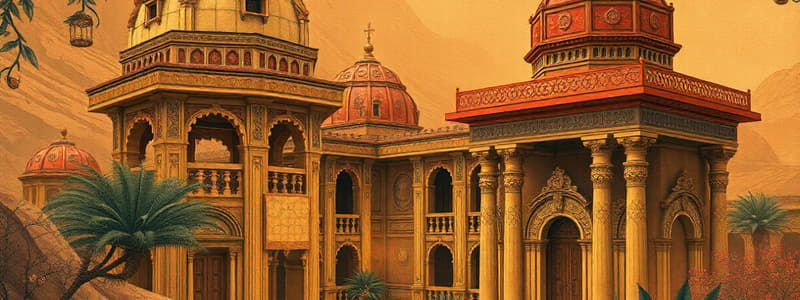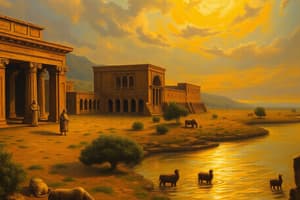Podcast
Questions and Answers
Which characteristic was LEAST likely a defining aspect of ancient civilizations?
Which characteristic was LEAST likely a defining aspect of ancient civilizations?
- Development of urban centers as hubs for commerce and culture
- Advancements in agricultural techniques to support larger populations
- Widespread adoption of democratic principles in governance (correct)
- Complex social hierarchies with specialized labor
How did the development of agriculture fundamentally change human societies during the rise of ancient civilizations?
How did the development of agriculture fundamentally change human societies during the rise of ancient civilizations?
- It decreased the need for social hierarchies and specialized labor.
- It led to the creation of settled communities and the growth of cities. (correct)
- It reduced the importance of trade and economic exchange between regions.
- It allowed for nomadic lifestyles to become more sustainable.
Which of the following statements accurately reflects a key achievement or characteristic of Mesopotamian civilization?
Which of the following statements accurately reflects a key achievement or characteristic of Mesopotamian civilization?
- The construction of elaborate pyramids as tombs for pharaohs
- The development of cuneiform writing and city-states like Ur (correct)
- The establishment of a unified empire under the rule of Pericles.
- The creation of an advanced sanitation system in urban centers
What was a significant difference between the political structures of Ancient Greece and Ancient Rome?
What was a significant difference between the political structures of Ancient Greece and Ancient Rome?
How did the geography of Ancient Egypt, particularly the Nile River, influence its civilization?
How did the geography of Ancient Egypt, particularly the Nile River, influence its civilization?
What role did religion play in the social and political structures of many ancient civilizations?
What role did religion play in the social and political structures of many ancient civilizations?
Which innovation had the GREATEST impact on the ability of ancient civilizations to record information and transmit knowledge across generations?
Which innovation had the GREATEST impact on the ability of ancient civilizations to record information and transmit knowledge across generations?
What common challenge did many ancient civilizations face that ultimately contributed to their decline or collapse?
What common challenge did many ancient civilizations face that ultimately contributed to their decline or collapse?
How did the concept of 'specialization of labor' contribute to the growth and complexity of ancient civilizations?
How did the concept of 'specialization of labor' contribute to the growth and complexity of ancient civilizations?
Which of these technologies were crucial for managing water resources and increasing agricultural productivity in ancient civilizations?
Which of these technologies were crucial for managing water resources and increasing agricultural productivity in ancient civilizations?
Flashcards
Ancient Civilizations
Ancient Civilizations
The first settled, stable communities that formed the foundation for later states, nations, and empires.
Urban Centers
Urban Centers
The rise of cities as hubs for population, commerce, and culture.
Complex Social Structures
Complex Social Structures
Hierarchical structures featuring distinct classes and specialized labor.
Formalized Political Systems
Formalized Political Systems
Signup and view all the flashcards
Development of Agriculture
Development of Agriculture
Signup and view all the flashcards
Mesopotamia Location
Mesopotamia Location
Signup and view all the flashcards
Ancient Egypt Political System
Ancient Egypt Political System
Signup and view all the flashcards
Indus Valley Urban Planning
Indus Valley Urban Planning
Signup and view all the flashcards
Ancient Greece City-States
Ancient Greece City-States
Signup and view all the flashcards
Trade
Trade
Signup and view all the flashcards
Study Notes
- Ancient civilizations refer to the first settled and stable communities that became the basis for later states, nations, and empires.
Characteristics of Ancient Civilizations
- Ancient civilizations were characterized by the rise of cities as centers of population, commerce, and culture.
- These societies developed hierarchical social structures with different classes and specialized labor.
- Ancient civilizations had organized governments and legal systems to maintain order and manage resources.
- The ability to produce surplus food through agriculture was crucial for supporting larger populations and specialized labor.
- Development of culture including art, architecture, religion, and intellectual pursuits such as writing and science.
Mesopotamia (c. 3500-539 BCE)
- Located in the Fertile Crescent between the Tigris and Euphrates rivers in modern-day Iraq, Kuwait, Turkey and Syria.
- Sumerians developed cuneiform writing, irrigation techniques, ziggurats (temples), and city-states like Ur and Uruk.
- Hammurabi created one of the earliest known law codes.
- Assyrians were known for their military prowess and centralized empire.
Ancient Egypt (c. 3100-30 BCE)
- Centered along the Nile River in northeastern Africa.
- Ruled by pharaohs considered divine rulers.
- Construction of pyramids as tombs, hieroglyphic writing, advancements in mathematics and medicine occurred.
- Polytheistic, with a complex belief system centered on the afterlife.
Indus Valley Civilization (c. 3300-1700 BCE)
- Present-day Pakistan and northwest India, along the Indus River
- Known for its well-planned cities like Mohenjo-daro and Harappa, with advanced sanitation systems.
- Developed a writing system that remains undeciphered.
- Engaged in trade with Mesopotamia and other regions.
Ancient China (c. 2000 BCE - 220 CE)
- Successive dynasties such as Xia, Shang, and Zhou ruled over different periods.
- Development of writing, bronze metallurgy, silk production, and the construction of the Great Wall.
- Confucianism and Daoism emerged during the Zhou dynasty, influencing Chinese society and governance.
Ancient Greece (c. 2700-146 BCE)
- Consisted of independent city-states like Athens and Sparta, each with its own government and culture.
- Athens developed the first known democracy under leaders like Pericles.
- Philosophy (Socrates, Plato, Aristotle), mathematics (Euclid, Pythagoras), and literature (Homer) were created.
- The Peloponnesian War between Athens and Sparta weakened the Greek city-states.
Roman Civilization (c. 753 BCE - 476 CE)
- The Roman Republic was characterized by a system of elected officials and representative assemblies.
- Transitioned into an empire under Augustus, expanding its control over a vast territory in Europe, North Africa, and the Middle East.
- Achievements include law, engineering (aqueducts, roads), architecture (Colosseum, Pantheon), and literature (Virgil, Cicero).
- Factors such as political instability, economic problems, and barbarian invasions led to the decline and fall of the Western Roman Empire.
Social Structures
- Hierarchical societies with distinct social classes.
- Kings, priests, and nobles held the highest positions of power and privilege.
- Farmers, artisans, and merchants formed the majority of the population.
- Slavery was a common feature in many ancient civilizations.
Political Systems
- Monarchies are rule by kings or emperors who inherited their positions.
- Theocracies are rule by religious leaders or in the name of gods.
- Republics are systems of government with elected officials and representative assemblies.
Economic Systems
- Agriculture was the foundation of ancient economies, with crops such as wheat, barley, rice, and maize being cultivated.
- Trade occurred as an exchange of goods and services between different regions and civilizations.
- Development of specialized labor and crafts, such as pottery, metalworking, and weaving.
Religion and Culture
- Polytheism is the belief in multiple gods and goddesses, each with their own powers and domains.
- Temples were constructed as places of worship and centers of religious activity.
- Complex systems of myths and legends explained the world and human existence.
Technology and Innovation
- Irrigation systems managed water resources and increase agricultural productivity.
- Writing systems recorded information and communicate ideas.
- Discovery and use of metals such as copper, bronze, and iron for tools, weapons, and ornaments.
- Construction of monumental structures such as pyramids, temples, and palaces.
Studying That Suits You
Use AI to generate personalized quizzes and flashcards to suit your learning preferences.




